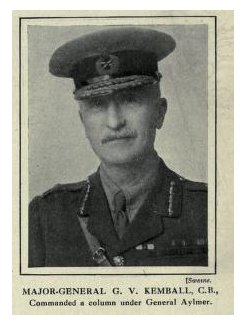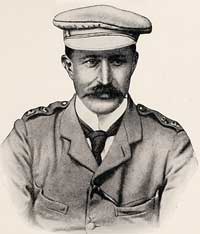
Marshal of the Royal Air Force Hugh Montague Trenchard, 1st Viscount Trenchard, was a British officer who was instrumental in establishing the Royal Air Force. He has been described as the "Father of the Royal Air Force."
This is the complete order of battle of opposing forces at the Battle of Balaclava.

The West African Frontier Force (WAFF) was a multi-battalion field force, formed by the British Colonial Office in 1900 to garrison the West African colonies of Nigeria, Gold Coast, Sierra Leone and Gambia. In 1928, it received royal recognition, becoming the Royal West African Frontier Force (RWAFF).

The British Expeditionary Force order of battle 1914, as originally despatched to France in August and September 1914, at the beginning of World War I. The British Army prior to World War I traced its origins to the increasing demands of imperial expansion together with inefficiencies highlighted during the Crimean War, which led to the Cardwell and Childers Reforms of the late 19th century. These gave the British Army its modern shape, and defined its regimental system. The Haldane Reforms of 1907 formally created an Expeditionary force and the Territorial Force.

Major-General Sir George Vere Kemball, KCMG, CB, DSO, R.A. (1859–1941) was a British Army officer of the 19th and early 20th century. He was a career officer in the British Army spending most of his career in India and Nigeria.

General Sir William Charles Giffard Heneker, was a Canadian soldier who served with the British Army in West Africa, India, and then later on the Western Front during the First World War. A notable military strategist and tactician, he became one of the most experienced and highly decorated Canadians in the British Empire, and one of only a handful of Canadians to reach the rank of full general.

Major-General Sir Henry Jenner Scobell, KCVO, CB was a British military leader who served as the last officer in command of Cape Colony before the formation of the Union of South Africa.
Hugh Trenchard saw service in Nigeria from 1903 to 1910 where he was involved in efforts to bring the interior under settled British rule and quell inter-tribal violence. During his time in West Africa, Trenchard commanded the Southern Nigeria Regiment for several years and was promoted to lieutenant colonel.
Major-General Sir Wilkinson Dent Bird, was an officer of the British Army during the late-19th century and the First World War.

General Sir Thomas Astley Cubitt, was a British Army officer of the late nineteenth and early twentieth centuries, who commanded a division in the First World War and in retirement served as Governor of Bermuda.
The 1905 Birthday Honours for the British Empire were announced on 30 June, to celebrate the birthday of Edward VII on 9 November.
Brigadier-General Malcolm Orme Little, was a cavalry officer in the British Army and champion polo player. He commanded a cavalry brigade in the Second Boer War and a yeomanry brigade in the First World War.
The 1915 Birthday Honours were appointments by King George V to various orders and honours to reward and highlight good works by citizens of the British Empire. The appointments were made to celebrate the official birthday of The King, and were published in The London Gazette and in The Times on 3 June 1915.
The 1917 Birthday Honours were appointments by King George V to various orders and honours to reward and highlight good works by citizens of the British Empire. The appointments were made to celebrate the official birthday of The King, and were published on 4 June and 19 June.
The 1918 Birthday Honours were appointments by King George V to various orders and honours to reward and highlight good works by citizens of the British Empire. The appointments were made to celebrate the official birthday of The King, 3 June and were published in The London Gazette on the same day, followed by a supplement.
The 1917 New Year Honours were appointments by King George V to various orders and honours to reward and highlight good works by citizens of the British Empire. The appointments were published in several editions of The London Gazette in January and February.
The 1919 New Year Honours were appointments by King George V to various orders and honours to reward and highlight good works by citizens of the British Empire. The appointments were published in The London Gazette and The Times in January 1919.
The Structure of the Egyptian Expeditionary Force over the course of the First World War is shown below.
This page is based on this
Wikipedia article Text is available under the
CC BY-SA 4.0 license; additional terms may apply.
Images, videos and audio are available under their respective licenses.







